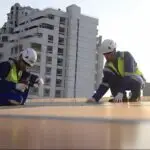Did you know that approximately 40% of roofing system failures are caused by preventable errors? Even small oversights can lead to costly repairs and disrupt your business operations. For property owners, ensuring a durable and reliable roof is essential to protect your investment.
In this article, we’ll explore the 10 most common mistakes to avoid when working on your roof. From choosing the right material to proper installation techniques, we’ll provide actionable advice to help you save time and money.
- Common Membrane Installation Flaws
- Incorrect Fluid-Applied Roofing Methods
- Selecting the Incorrect Roofing Materials
- Overlooking Structural Considerations
- Neglecting Professional Expertise
- Failing to Plan for Maintenance and Longevity
- Overcomplicating the Roofing Project
- Ineffective Cost Management
- Skipping Pre-Installation Inspections
- Ignoring Collaboration Between Teams
Key Takeaways
- Small errors in roofing systems can lead to expensive repairs.
- Proper material selection is crucial for long-term durability.
- Professional installation ensures the longevity of your roof.
- Regular maintenance helps prevent unexpected issues.
- Working with a trusted local company guarantees quality results.
Understanding the Basics of Commercial Roofing
When it comes to protecting large-scale properties, understanding the basics is crucial. A well-designed roof is more than just a covering; it’s a system that ensures safety, durability, and energy efficiency. For property owners, investing in the right solution can save time, money, and stress in the long run.
Defining Commercial Roofing and Its Importance
Commercial roofing refers to the materials and methods used to protect large buildings like offices, warehouses, and retail spaces. Unlike residential systems, these roofs are often flat or low-sloped, designed to handle heavier loads and larger areas. Proper installation and material selection are essential to prevent leaks, structural damage, and costly repairs.
Comparing Commercial and Residential Systems
While both types of roofs serve the same purpose, they differ significantly in design and complexity. Residential roofs typically use asphalt shingles and have steeper slopes for water runoff. In contrast, commercial systems often rely on materials like TPO, PVC, or EPDM, which are better suited for flat surfaces and larger spans.
Another key difference is the level of expertise required. Commercial projects demand skilled roofers who understand the unique challenges of large-scale installations. From single-ply membranes to built-up roofing (BUR), each option has its own benefits and requires precise workmanship.
Choosing the right solution for your building is a critical decision. Whether you’re a property owner or a manager, working with a trusted company ensures your investment is protected for years to come.
Identifying Critical Installation Errors
Even the smallest oversight during installation can lead to significant issues down the line. A well-executed installation ensures your roof performs as intended, protecting your property for years. However, common mistakes can compromise the entire project, leading to leaks, structural damage, and costly repairs.
Common Membrane Installation Flaws
Membrane systems are popular for their durability and flexibility, but improper installation can negate these benefits. One of the most frequent errors is inadequate seam sealing, which can lead to water infiltration. Even a small gap can allow moisture to seep in, causing long-term damage.
Another issue is improper adhesion. If the membrane isn’t correctly bonded to the substrate, it can lift or wrinkle, creating weak points. This often happens when the surface isn’t properly cleaned or prepared before installation. Attention to detail is crucial to avoid these pitfalls.
Pitfalls in Fluid-Applied Roofing Methods
Fluid-applied systems offer seamless protection, but they come with their own set of challenges. One common mistake is uneven application, which can result in thin spots that are prone to failure. This often occurs when the material isn’t spread evenly or the surface isn’t properly primed.
Another risk is improper curing. If the material doesn’t cure correctly due to temperature or humidity issues, it can fail to bond properly. This highlights the importance of working with a certified roofer who understands the nuances of these systems.
To avoid these errors, we recommend thorough inspections and working with experienced professionals. A skilled team ensures your installation is done right the first time, saving you time and money in the long run.
Selecting the Wrong Roofing Materials
Selecting the right materials for your roof is a decision that impacts its longevity and performance. The wrong choice can lead to premature failure, higher maintenance costs, and unnecessary stress.
Evaluating PVC, TPO, and Single-Ply Options
When it comes to roofing materials, PVC, TPO, and single-ply systems are popular choices. Each has its own strengths and weaknesses, making it essential to understand their differences. PVC is known for its durability and resistance to chemicals, making it ideal for buildings with specific environmental challenges. However, it can be more expensive than other options.
TPO is a cost-effective choice that offers excellent energy efficiency and UV resistance. It’s a versatile material suitable for many projects, but improper installation can lead to seam failures. Single-ply systems, on the other hand, are lightweight and easy to install, but they may require more frequent maintenance.
Material | Benefits | Downsides |
PVC | Durable, chemical-resistant | Higher cost |
TPO | Cost-effective, energy-efficient | Prone to seam issues |
Single-Ply | Lightweight, easy to install | Requires more maintenance |
Misselecting materials can lead to significant problems, including leaks and structural damage. That’s why we recommend working with a trusted team that has the experience to guide you. Our company ensures every project is tailored to your building’s needs, providing long-lasting solutions you can rely on.
Overlooking Structural Considerations
The foundation of a strong roof lies in its underlying structure. Ignoring this can lead to significant issues, from leaks to complete system failure.
Ensuring Proper Decking and Support
Structural integrity is crucial for the performance of any roof. The decking and support systems must align with the chosen materials and installation methods. Common commercial roofing mistakes include using inadequate materials or failing to assess the load-bearing capacity of the structure.
Before starting any project, we recommend a thorough inspection. Look for potential weak spots, such as rotting wood or rusted metal. Addressing these issues early can prevent costly repairs down the line.
Collaboration between the roofing team and structural engineers is essential. This ensures the design meets both safety standards and the specific needs of your property. A well-planned approach guarantees a durable and reliable roof.
Consideration | Common Mistakes | Best Practices |
Decking Material | Using low-quality wood | Choose durable, weather-resistant materials |
Support Systems | Ignoring load capacity | Assess and reinforce as needed |
Inspection | Skipping pre-installation checks | Identify and fix weak spots early |
At our company, we combine experience with a commitment to quality. Our team ensures every project is tailored to your building’s needs, providing long-lasting solutions you can trust.
Neglecting Professional Expertise
The success of any large-scale project often hinges on the expertise of the team behind it. For complex installations, hiring certified professionals isn’t just a recommendation—it’s a necessity. Without the right skills and experience, even the best materials can fail to deliver long-term results.
The Importance of Certified Installers
Certified installers bring a level of precision and knowledge that untrained personnel simply can’t match. They understand the nuances of different systems, ensuring every detail is handled correctly. This expertise is especially critical for large-scale projects, where even minor errors can lead to costly repairs.
Working with a certified roofer also provides peace of mind. These professionals are trained to meet industry standards, reducing the risk of future issues. Their attention to detail ensures your project is completed efficiently and effectively.
Comparing Commercial and Residential Expertise
While residential roofers are skilled in their own right, commercial projects require a different level of expertise. The scale and complexity of these installations demand specialized knowledge. For example, handling flat or low-sloped surfaces requires techniques that differ from traditional residential work.
Here’s a quick comparison of the two:
- Residential Roofer: Focuses on steeper slopes and smaller areas.
- Commercial Roofer: Handles larger surfaces, often with unique materials and methods.
Risks of Untrained Personnel
Using untrained or uncertified personnel can lead to significant risks. Poor workmanship often results in leaks, structural damage, and premature system failure. These issues not only increase costs but also disrupt your business operations.
At our company, we’ve seen firsthand the consequences of cutting corners. That’s why we emphasize the importance of hiring a skilled team for every project. Quality workmanship isn’t just about aesthetics—it’s about ensuring your investment lasts for years to come.
Partnering with experienced professionals builds long-term confidence and customer satisfaction. When you choose the right team, you’re not just getting a roof—you’re getting peace of mind.
Failing to Plan for Maintenance and Longevity
Planning for maintenance is as crucial as the initial installation. A well-maintained roof not only extends its lifespan but also prevents costly repairs. At our company, we emphasize the importance of proactive care to ensure your property remains secure for years to come.
Preventative Maintenance Practices to Avoid Costly Repairs
Regular inspections are the cornerstone of effective maintenance. Small issues, like loose seams or minor leaks, can escalate into major problems if left unchecked. By scheduling routine checks, you can identify and address potential weaknesses early.
Here are some key practices to follow:
- Inspect the system at least twice a year, especially after severe weather.
- Clear debris from drains and gutters to prevent water buildup.
- Address minor repairs promptly to avoid larger issues.
Leveraging Non-Prorated Warranties and Guarantees
Non-prorated warranties are a valuable resource for property owners. Unlike prorated options, these warranties cover the full cost of repairs or replacements over their term. This ensures your investment is protected without unexpected expenses.
Here’s a comparison of warranty types:
Warranty Type | Coverage | Cost Over Time |
Non-Prorated | Full repair/replacement cost | Higher upfront, lower long-term |
Prorated | Partial cost based on age | Lower upfront, higher long-term |
Integrating maintenance planning into your overall business strategy is a smart move. It not only saves money but also ensures your property remains in top condition. At our company, we’re here to help you every step of the way.
Overcomplicating the Roofing Project
Keeping a roofing project simple is often the key to its success. Overcomplicating the process can lead to delays, budget overruns, and unnecessary stress. At our company, we’ve seen how a clear, straightforward approach ensures smoother execution and better results.
One common mistake is adding too many options or features that aren’t essential. This can confuse stakeholders and slow down decision-making. Instead, focus on the core needs of your property. A well-defined plan with clear goals keeps everyone on the same page.
Effective communication is another critical factor. Misunderstandings between the team, property owners, and contractors can derail even the best-laid plans. Regular updates and transparent discussions help avoid these pitfalls.
Standardized procedures also play a vital role. Using proven methods for installation ensures consistency and reduces the risk of errors. This approach not only saves time but also keeps costs in check.
For property owners and managers, the key is to work with a trusted roofer who understands the importance of simplicity. A skilled company will guide you through the process, ensuring your project stays on track and within budget.
By avoiding unnecessary complexity, you can achieve a durable and efficient roof that meets your needs. A straightforward approach not only saves resources but also builds confidence in the final result.
Effective Cost Management in Large Roofing Projects
Managing costs effectively is critical for the success of any large-scale project. At our company, we understand that accurate budgeting and strategic planning are essential to keep your project on track. Whether you’re working on a commercial building or a residential property, controlling expenses without compromising quality is a top priority.
Budgeting Strategies and Contract Considerations
Creating a detailed budget is the first step in effective cost management. Start by estimating material and labor costs, then add a contingency fund for unexpected expenses. This approach ensures you’re prepared for any surprises that may arise during the work.
Contracts play a vital role in cost control. Include clear terms for payment schedules, deliverables, and dispute resolution. Adding contingency clauses can protect both the roofer and the property owner from unforeseen costs. A well-drafted agreement sets the foundation for a smooth and transparent project.
Minimizing Unforeseen Expenses
Unexpected costs can quickly derail your budget. To avoid this, conduct a thorough site inspection before starting the installation. Identify potential issues like structural weaknesses or outdated systems that may require additional work.
Another strategy is to source high-quality materials from trusted suppliers. While this may involve a higher upfront cost, it reduces the risk of frequent repairs and replacements. Partnering with an experienced team ensures the job is done right the first time, saving you money in the long run.
By focusing on proactive planning and clear communication, you can minimize unforeseen expenses and keep your project within budget. At our company, we’re here to help you every step of the way, ensuring your investment delivers lasting value.
Summary
Ensuring a durable and reliable roof starts with avoiding common pitfalls. Throughout this article, we’ve highlighted the common commercial roofing mistakes that can compromise your property’s protection. From improper installation to selecting the incorrect roofing materials, these errors can lead to costly repairs and reduced longevity.
By following the best practices we’ve shared, you can safeguard your investment. Always choose a certified team with the right experience to handle your project. Quality work and the right system ensure your roof performs as intended for years to come.
At DB Roofing LLC, we’re here to help you every step of the way. Our company combines expertise with a commitment to our local community. Contact us today for expert advice and solutions tailored to your needs.
FAQs SECTION
Frequently Asked Questions
Commercial systems are designed for larger structures like office buildings and warehouses, focusing on durability and weather resistance. Residential systems, on the other hand, are tailored for homes, often prioritizing aesthetics alongside protection.
Common flaws include improper sealing, uneven application, and failure to account for expansion and contraction. These issues can lead to leaks and reduced lifespan of the roofing material.
PVC is known for its durability and chemical resistance, TPO offers energy efficiency and flexibility, while single-ply systems are lightweight and easy to install. The best choice depends on your building’s needs and budget.
Proper decking and support ensure the structural integrity of your roof. Weak or damaged decking can lead to sagging, leaks, and even collapse, compromising the safety of the building.
Certified installers have the training and experience to handle complex projects, ensuring quality workmanship and adherence to industry standards. This reduces the risk of errors and costly repairs down the line.
Preventative maintenance helps identify and address minor issues before they become major problems. This extends the lifespan of your roof and saves money on repairs over time.
Effective budgeting, detailed contracts, and regular communication with your contractor can help minimize unforeseen expenses. Planning ahead and choosing the right materials also play a key role in cost management. Contact us for a free estimate.









